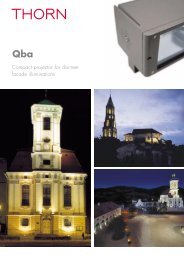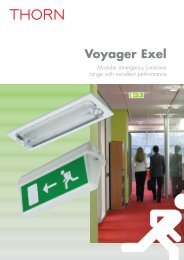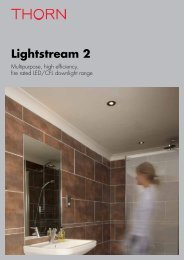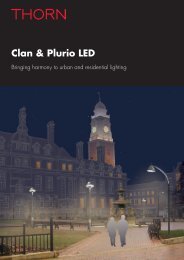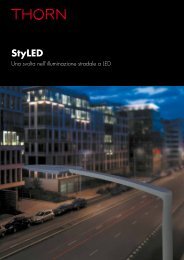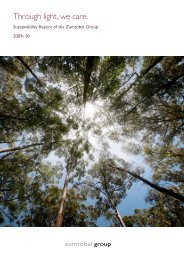Download the Thorn Lighting and Sustainability brochure
Download the Thorn Lighting and Sustainability brochure
Download the Thorn Lighting and Sustainability brochure
You also want an ePaper? Increase the reach of your titles
YUMPU automatically turns print PDFs into web optimized ePapers that Google loves.
All our suppliers <strong>and</strong> service providers have to<br />
conform to <strong>the</strong> required national <strong>and</strong> international<br />
regulations <strong>and</strong> company st<strong>and</strong>ards which are<br />
defined <strong>and</strong> specified<br />
Restriction of Hazardous<br />
Substances (RoHS) Directive<br />
Promoting a cleaner<br />
environment by<br />
minimisising harmful<br />
substances in emergency<br />
lighting batteries<br />
The Packaging Directive<br />
The RoHS Directive st<strong>and</strong>s for “<strong>the</strong> restriction of <strong>the</strong> use of certain<br />
hazardous substances in electrical <strong>and</strong> electronic equipment”. This<br />
directive bans <strong>the</strong> placing on <strong>the</strong> EU market of new electrical <strong>and</strong><br />
electronic equipment containing more than agreed levels of hazardous<br />
substances (lead, cadmium, mercury, hexavalent chromium), plus two<br />
flame retardants often found in plastics, PBB <strong>and</strong> PBDE.<br />
All st<strong>and</strong>ard catalogued <strong>Thorn</strong> products designed <strong>and</strong> manufactured<br />
since 1st July 2006 conform to <strong>the</strong> requirements.<br />
Following a new environmental focus <strong>the</strong> new EU Batteries <strong>and</strong><br />
Accumulators (rechargeable batteries) Directive (2006/66/EC) came<br />
into force in September 2008 replacing <strong>the</strong> previous battery directive<br />
(91/157/EEC).<br />
One of its key aims is to effectively ban <strong>the</strong> use of nickel cadmium<br />
(NiCd), o<strong>the</strong>r than for specific exemptions, including emergency<br />
lighting. Naturally, EU officials are concerned about <strong>the</strong> environmental<br />
<strong>and</strong> health hazards posed by used batteries which contain toxic metals<br />
such as cadmium, when <strong>the</strong>y go to l<strong>and</strong>fill. Additional aims include<br />
designing for “easy” removal of batteries at end-of-life, more efficient<br />
waste management <strong>and</strong> better labelling.<br />
Realising that <strong>the</strong> directive is an important step towards a greener<br />
society, even though emergency lighting products are exempt, <strong>and</strong><br />
appreciating that customers are more likely to chose products that<br />
pollute less, <strong>Thorn</strong> is taking <strong>the</strong> leading step of using substitutes such as<br />
Nickel Metal Hydride (NiMH) as a cadmium free replacement for NiCd<br />
batteries in its emergency lighting products. Against <strong>the</strong> slow response<br />
of most lighting manufacturers <strong>the</strong> company aims to change-over 50%<br />
of its emergency lighting portfolio by April 30, 2010.<br />
The use of NiMH brings o<strong>the</strong>r benefits: <strong>the</strong>y offer greater battery<br />
capacity per volume resulting in smaller units <strong>and</strong> have superior<br />
recharge characteristics in that <strong>the</strong>y do not suffer from <strong>the</strong> “memory<br />
effect”. This occurs when a NiCd battery is only partially discharged<br />
before its next recharge. The battery <strong>the</strong>n “forgets” it has <strong>the</strong> capacity<br />
to fur<strong>the</strong>r discharge <strong>and</strong>, although functional, remains stuck at <strong>the</strong><br />
lower, partially discharged capacity.<br />
Whilst conducting this conversion program <strong>Thorn</strong> is also designing<br />
emergency lighting products in such a way that <strong>the</strong> battery can be<br />
more easily removed.<br />
Packaging legislation is driven by <strong>the</strong> Packaging & Packaging Waste<br />
Directive (94/62/EC) - which is concerned with minimising <strong>the</strong> creation<br />
of packaging waste material <strong>and</strong> promotes energy recovery, re-use<br />
<strong>and</strong> recycling of packaging. <strong>Thorn</strong> focusses particularly on packaging<br />
composition, reusability, recoverability, <strong>and</strong> <strong>the</strong> ability to recycle.<br />
Voyager LED<br />
In <strong>the</strong> Voyager LED range <strong>the</strong> NiMH batteries<br />
are not encased in <strong>the</strong> LED gear, thus<br />
complying with regulations, avoiding any<br />
operational heat issues <strong>and</strong> allowing quick<br />
replacement without tools. As well as <strong>the</strong>ir<br />
long operating lives, <strong>the</strong> LEDs employed<br />
offer considerable energy savings. Voyager<br />
LED units typically consume only 15 percent<br />
of <strong>the</strong> power of a st<strong>and</strong>ard solution for <strong>the</strong><br />
same light output. They enable designers to<br />
specify fittings that are more aes<strong>the</strong>tically<br />
pleasing, consume less power, require<br />
smaller power supplies, run for longer<br />
periods than before <strong>and</strong> give a better quality<br />
of life through a cleaner environment.<br />
Regent Street Project<br />
With <strong>the</strong> aim to reduce waste, lower cost<br />
<strong>and</strong> increase efficiency a recent reusable<br />
packaging initiative was designed by<br />
<strong>Thorn</strong> Spennymoor for <strong>the</strong> W8 Project on<br />
Regent Street, London. By using reuseable<br />
polypropylene trays with foam inserts (for<br />
product location/separation) that accept<br />
eight modular fluorescent luminaires <strong>and</strong><br />
<strong>the</strong>n stretch wrapping <strong>the</strong>m onto pallets<br />
packaging waste has been reduced,<br />
installation speeded up (<strong>the</strong> fittings were<br />
supplied with flying leads) <strong>and</strong><br />
20,000 euros saved.<br />
21


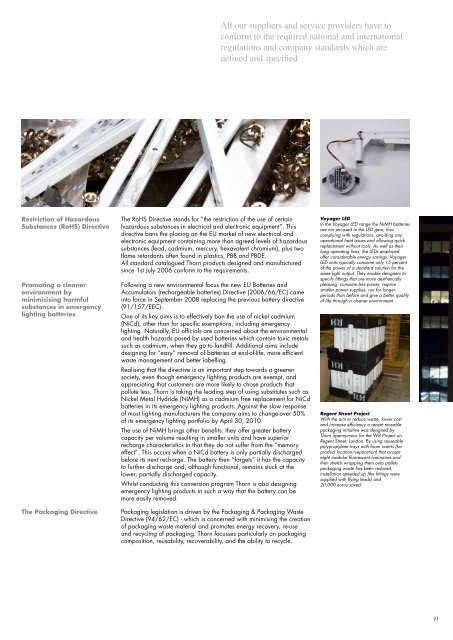
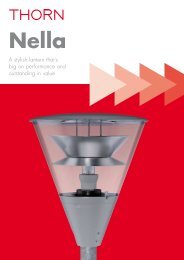
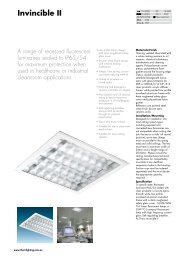
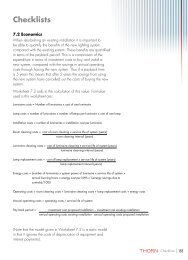
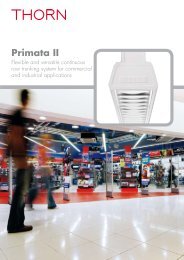
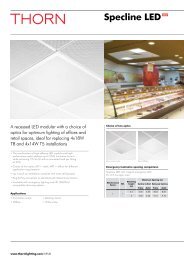

![Produkt brochure [PDF/4MB] - THORN Lighting](https://img.yumpu.com/50705283/1/184x260/produkt-brochure-pdf-4mb-thorn-lighting.jpg?quality=85)
